First released in 1994, The Shawshank Redemption tanked at the box office. In the run up to the film’s silver jubilee on 10 September, Saumya Mehrotra revisits the classic and its remarkable history.
The Shawshank Redemption is an unlikely entry in the league of Hollywood classics. Based on a 1982 novella by Stephen King, titled Rita Hayworth and Shawshank Redemption, the film was released on 10 September 1994, and it received a mild response from the audiences. Even in commercial terms, it was a failure, earning a total of $24 million, one million less than the total budget of the movie.
With the film completing its silver jubilee on 10 September 2019, it’s worth asking why a barely noticed yesteryear flop emerged as one of American cinema’s biggest international successes.
To mark its 25 years in the limelight, The Shawshank Redemption is being re-released in select theatres across the United States of America. In the run up to the big day, the film is also being written about in magazines and newspapers worldwide. It’s likely that millions of viewers would be introduced to this classic in the coming days, and that The Shawshank Redemption would regain the Number One spot on the popular movie rating website, IMDb. (It was IMDb’s top-ranked film for 11 years, until it was overtaken by The Godfather in 2008.)
Nevertheless, it has appeared in almost all the major “greatest films” lists published anywhere, and has been lauded by critics for its screenplay and performances.
The film began to gain popularity around a year after its release, thanks to the spate of Oscar nominations it had received. Though it was nominated in seven categories, including “Best Picture”, it failed to win in any. This, however, was when the film got the kind of attention it deserved.
Director Frank Darabont had a theory about the film not doing well at the time of its release. In an interview, he once said that the 1990s audiences couldn’t quite connect with a slow-paced prison movie. Some of the cast, including Morgan Freeman, reportedly believed that the film was not marketed well, and so it couldn’t get any traction with the theatre-going audiences.
The film’s release almost coincided with the rise of cable TV in America and the rest of the world. By the mid-’90s, it was already ranked among the TV favourites of all time. In fact, it was The Shawshank Redemption that made Hollywood producers think seriously about tapping into the television industry. After this point in cinema history, films were made for both the big screen and for the small one.
But what was it about the film’s content that made it click with such a huge audience, though? There are some standout performances in it, by both the leads, Tim Robbins and Freeman. The cinematography is commendable. And the plot is as engaging as the spiritual message of hope it delivers.
It’s not as though the film is without faults. The slow pace that Darabont was referring to is unfortunately a real shortcoming. There are too many banal sequences portraying the daily routine of prison life. The philosophical bent of the plot also weighs too heavily on the overall film. The social message attached to it—about the virtues of patience—is too sentimental for our times.
Aside from the sentimentality and dramatics, the film offers many enjoyable moments. For instance, the scenes of camaraderie among the prisoners, the sequence in which music is played for the first time through the prison’s PA system.
The Shawshank Redemption is set in the Ohio State Reformatory, which opened in 1896. It was made for an exclusively American audience, and was concerned with American themes of law and justice. Yet the impact of the film has been nothing less than global. Nelson Mandela was among its fans. Indian filmmakers and actors have paid tributes to it as well. Sriram Raghavan, director of Badlapur, was heavily influenced by it. In 2003, filmmaker Nagesh Kukunoor made his own version of The Shawshank Redemption, called 3 Deewarein.
On the 25th anniversary of this classic, it would certainly be worth everyone’s while to revisit The Shawshank Redemption, and to remember it as a major landmark in cinema history.

